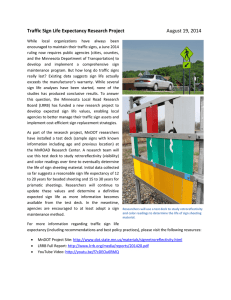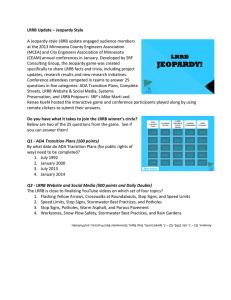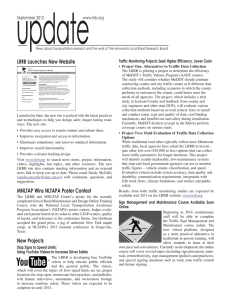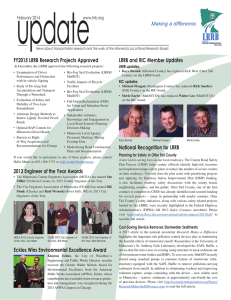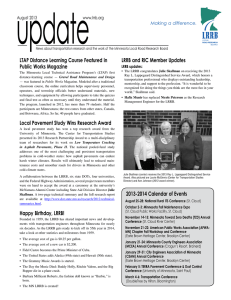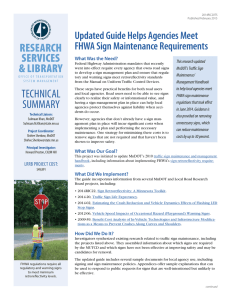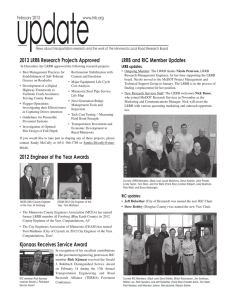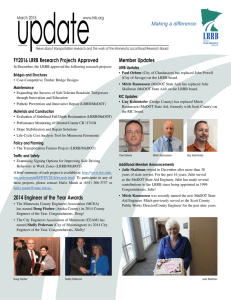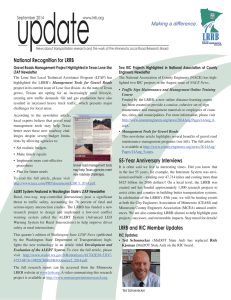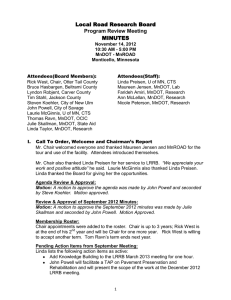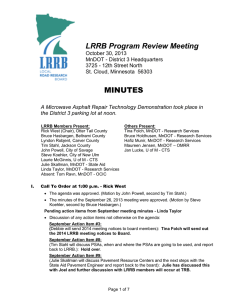update National Recognition for LRRB Member Updates Making a difference.
advertisement
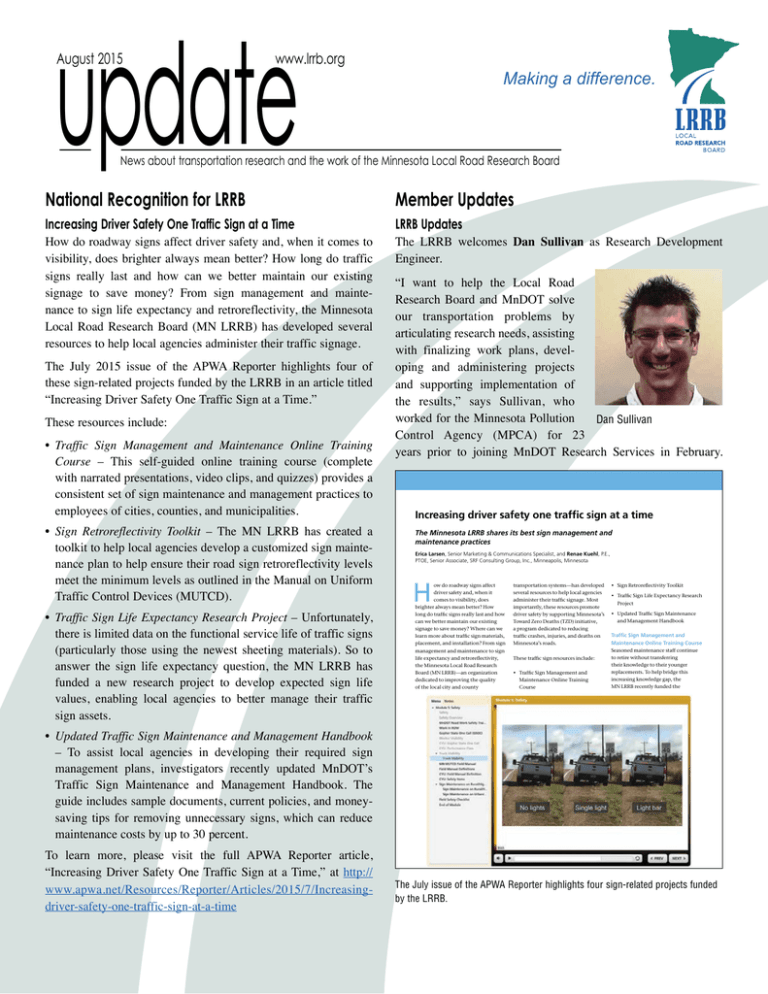
update August 2015 www.lrrb.org Making a difference. News about transportation research and the work of the Minnesota Local Road Research Board National Recognition for LRRB Member Updates Increasing Driver Safety One Traffic Sign at a Time LRRB Updates How do roadway signs affect driver safety and, when it comes to visibility, does brighter always mean better? How long do traffic signs really last and how can we better maintain our existing signage to save money? From sign management and maintenance to sign life expectancy and retroreflectivity, the Minnesota Local Road Research Board (MN LRRB) has developed several resources to help local agencies administer their traffic signage. The July 2015 issue of the APWA Reporter highlights four of these sign-related projects funded by the LRRB in an article titled “Increasing Driver Safety One Traffic Sign at a Time.” These resources include: • Traffic Sign Management and Maintenance Online Training Course – This self-guided online training course (complete with narrated presentations, video clips, and quizzes) provides a consistent set of sign maintenance and management practices to employees of cities, counties, and municipalities. • Sign Retroreflectivity Toolkit – The MN LRRB has created a toolkit to help local agencies develop a customized sign maintenance plan to help ensure their road sign retroreflectivity levels meet the minimum levels as outlined in the Manual on Uniform Traffic Control Devices (MUTCD). • Traffic Sign Life Expectancy Research Project – Unfortunately, there is limited data on the functional service life of traffic signs (particularly those using the newest sheeting materials). So to answer the sign life expectancy question, the MN LRRB has funded a new research project to develop expected sign life values, enabling local agencies to better manage their traffic sign assets. The LRRB welcomes Dan Sullivan as Research Development Engineer. “I want to help the Local Road Research Board and MnDOT solve our transportation problems by articulating research needs, assisting with finalizing work plans, developing and administering projects and supporting implementation of the results,” says Sullivan, who worked for the Minnesota Pollution Dan Sullivan Control Agency (MPCA) for 23 years prior to joining MnDOT Research Services in February. Increasing driver safety one traffic sign at a time The Minnesota LRRB shares its best sign management and maintenance practices Erica Larsen, Senior Marketing & Communications Specialist, and Renae Kuehl, P.E., PTOE, Senior Associate, SRF Consulting Group, Inc., Minneapolis, Minnesota H ow do roadway signs affect driver safety and, when it comes to visibility, does brighter always mean better? How long do traffic signs really last and how can we better maintain our existing signage to save money? Where can we learn more about traffic sign materials, placement, and installation? From sign management and maintenance to sign life expectancy and retroreflectivity, the Minnesota Local Road Research Board (MN LRRB)—an organization dedicated to improving the quality of the local city and county transportation systems—has developed several resources to help local agencies administer their traffic signage. Most importantly, these resources promote driver safety by supporting Minnesota’s Toward Zero Deaths (TZD) initiative, a program dedicated to reducing traffic crashes, injuries, and deaths on Minnesota’s roads. These traffic sign resources include: • Traffic Sign Management and Maintenance Online Training Course • Sign Retroreflectivity Toolkit • Traffic Sign Life Expectancy Research Project • Updated Traffic Sign Maintenance and Management Handbook Traffic Sign Management and Maintenance Online Training Course Seasoned maintenance staff continue to retire without transferring their knowledge to their younger replacements. To help bridge this increasing knowledge gap, the MN LRRB recently funded the • Updated Traffic Sign Maintenance and Management Handbook – To assist local agencies in developing their required sign management plans, investigators recently updated MnDOT’s Traffic Sign Maintenance and Management Handbook. The guide includes sample documents, current policies, and moneysaving tips for removing unnecessary signs, which can reduce maintenance costs by up to 30 percent. To learn more, please visit the full APWA Reporter article, “Increasing Driver Safety One Traffic Sign at a Time,” at http:// www.apwa.net/Resources/Reporter/Articles/2015/7/Increasingdriver-safety-one-traffic-sign-at-a-time A new Traffic Sign Management and Maintenance online training course includes narrated presentations and video clips to help local employees learn at their own pace. The July issue of the APWA APWA Reporter 2015 / Reporter www.apwa.net highlights four sign-related projects funded 38 / July by the LRRB. Highlighted LRRB Projects Weigh-in-Motion Projects • Portable Weigh-in-Motion System Accurate Enough for Low-Cost Screening – Heavy freight vehicles are a concern for many local agencies due to the damage they can cause to roads. While weigh-inmotion (WIM) systems can provide useful data about freight vehicles that use a given road, current systems are Portable weigh-in-motion systems provide a low-cost method for obtaining vehicle load expensive. They are also distribution data. permanent, requiring costly and intrusive pavement cuts or boring to install. Portable WIM systems provide a low-cost method for obtaining vehicle load distribution data across the state’s road network. The technical summary is available at http://www.lrrb.org/media/ reports/201503TS.pdf. • Improving Vehicle Classification at Weigh-in-Motion Sites – Accurate classification of freight vehicles and enforcement of weight restrictions are critical for maintaining our roads. This project investigated two innovations in freight weight enforcement. Researchers found that license plate reader camera technology is not ready for highway speed WIM sites. They also developed a revised vehicle classification scheme that can bring MnDOT’s separate schemes in use at WIM and automatic traffic recorder sites into alignment, improving data for planning and modeling. The technical summary is available at http://www. lrrb.org/media/reports/201517TS.pdf. • Improving Weigh-in-Motion Sensor Accuracy Between Calibrations – WIM sensors develop errors in the data they collect over time, but because of time and cost, MnDOT can calibrate them only twice per year. This project developed a software tool to identify data errors to improve data between calibrations. The technical summary is available at http://www. lrrb.org/media/reports/201518TS.pdf. Wave-Shaped Rumble Strips Reduce Nuisance Noise Although they serve as an effective warning to drivers, rumble strips can cause unwanted noise for nearby landowners when a vehicle drifts over a centerline or edgeline. Luckily, local researchers may have found a quieter rumble strip in California. A comparison study shows that California’s standard wave-shaped rumble produces less external noise while still producing enough sound inside the vehicle to alert inattentive drivers. A follow-up project is currently underway to test wider versions of sinusoidal rumble strips based on the California design. When that project is completed, the new rumble strip design should be available for implementation. To learn more, please visit the technical summary: http://www.dot.state.mn.us/research/TS/2015/201507TS.pdf. Timber Bridge Inspection Devices and Repair Techniques • Timber Bridge Life Spans Extended with Innovative Inspection Devices – Minnesota has more than 2,000 bridges that contain structural timber in the superstructure or substructure. Wooden bridges are praised for being environmentally friendly compared to other bridge types. However, they are prone to deterioration caused by moisture in the wood, fungi, insect attack, and mechanical damage. Because this damage often occurs within the wood rather than on the surface, deterioration in timber bridges can be difficult to detect with traditional inspection techniques such as visual inspection, sounding with a hammer, and coring. This research project identifies inspection techniques to help local engineers address deterioration and extend timber bridge life, saving agencies money in detour and bridge replacement costs. The technical summary is available at http://www. lrrb.org/media/reports/201501TS.pdf. • Timber Bridge Repair Techniques – This training opportunity and report are expected to be available this fall. Rural Intersection Lighting Reduces Nighttime Crash Rates In 2012, Minnesota reported 36 fatalities at rural intersections at night. While vehicle headlights offer some illumination, previous studies indicate overhead intersection lighting in rural locations helps reduce nighttime collision rates. This project collected various measurements at rural intersections and used that data to provide insight into appropriate lighting levels. The results suggest that installing just one overhead light at rural intersections can reduce the number of nighttime collisions. To learn more, please visit the technical summary: http://www.lrrb.org/media/ reports/201505TS.pdf. 2015 Calendar of Events October 7-8: Minnesota Fall Maintenance Expo St. Cloud Public Works Facility, St. Cloud, MN http://mnfallexpo.com/ October 29-30: Minnesota Toward Zero Deaths (TZD) Annual Conference St. Cloud River’s Edge Convention Center, St. Cloud, MN http://www.minnesotatzd.org/events/conference/2015/index.html November 19-20: American Public Works Association – Minnesota Chapter (APWA-MN) Fall Workshop and Conference Earle Brown Heritage Center, Brooklyn Center, MN http://www.apwa-mn.org/events-education/Fall-Conference/2015 January 19-22: Minnesota County Engineers Association (MCEA) Annual Conference Cragun’s Resort and Hotel, Brainerd, MN http://www.mncountyengineers.org/ January 28-30: City Engineers Association of Minnesota (CEAM) Annual Conference Earle Brown Heritage Center, Brooklyn Center, MN http://www.ceam.org/
